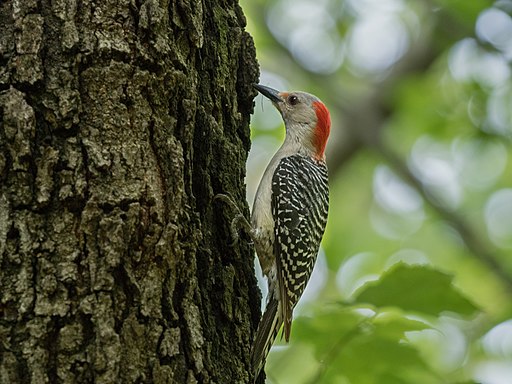Woodpeckers in Florida: Recognition Tips and Environment Preferences
Woodpeckers in Florida: Recognition Tips and Environment Preferences
Blog Article
Introducing the Tricks of Woodpeckers: Habits, Environment, and Much More
Woodpeckers, with their special actions and specialized adaptations, have actually long captivated scientists and nature fanatics alike. These impressive birds have a variety of intriguing tricks that dropped light on their survival strategies, environment preferences, and detailed interaction methods. By discovering the secrets bordering woodpeckers' behavior and environment options, a deeper understanding of these bird marvels emerges, providing a glance right into their fascinating globe. So, what makes these birds genuinely remarkable, and just how do they navigate their setting with such precision and skill? Let's check out the captivating world of woodpeckers and unravel the enigmatic details that make them such appealing subjects of research study.
Woodpecker Actions Insights
In examining woodpecker actions, a remarkable screen of specialized skills and adjustments emerges, clarifying their amazing environmental specific niche - Woodpeckers in Florida. Woodpeckers, recognized for their distinctive drumming on trees, have a variety of behavior characteristics that contribute to their survival and success in their setting. One essential actions is their drumming, which offers several functions such as communication, developing territory, bring in companions, and locating food resources. This rhythmic pecking also showcases their amazing stamina and endurance, as they can hammer away continuously at high speeds without creating injury to themselves.
Moreover, woodpeckers display a special feeding actions characterized by their ability to remove insects from tree bark using their specialized beaks. Their lengthy, barbed tongues help in capturing target, while their strong neck muscular tissues give stability and accuracy throughout pecking movements. This feeding technique permits woodpeckers to gain access to surprise insect larvae and remove them with remarkable performance.
Environment Preferences and Selection
What factors influence the habitat preferences and choice of woodpeckers? Woodpeckers are extremely versatile birds understood to occupy different settings worldwide. Nonetheless, they do show preferences for sure environment features. One important variable affecting woodpecker habitat option is the accessibility of suitable nesting sites. Woodpeckers commonly like forests with a mix of fully grown trees that offer sufficient possibilities for dental caries excavation. These cavities work as critical nesting and roosting sites for woodpeckers and are important for their reproducing success.
In addition, woodpeckers reveal a preference for environments with a bountiful supply of food sources. They are mainly insectivorous, preying on beetles, ants, larvae, and other pests discovered in decaying timber or tree bark. Woodpeckers often tend to prefer wooded areas with a varied insect populace to satisfy their dietary demands.
Additionally, the existence of dead or decaying trees is an additional vital aspect in woodpecker habitat option. These trees not only provide food resources however also use suitable substratum for tooth cavity excavation. Dead trees are important for the upkeep of healthy woodpecker populations, as they play a crucial role in the woodpeckers' life process and community characteristics.
Feeding Routines and Diet Structure
Woodpeckers demonstrate a specialized feeding habits concentrated on foraging for bugs within various environments. Their diet mostly includes bugs such as beetles, ants, caterpillars, and crawlers, which they locate by touching on tree bark and paying attention for the noise of activity inside. Woodpeckers use their solid beaks to pierce into the timber and their lengthy, barbed tongues to extract target from crevices. Along with pests, woodpeckers also take in tree sap, websites fruits, nuts, and seeds, including variety to their diet plan relying on the season and accessibility of food resources.
The foraging strategies of woodpeckers are well-adapted to their arboreal way of living (Woodpeckers in Florida). Their ability to excavate timber not just gives them with food yet additionally aids in developing nesting dental caries and developing regions. Woodpeckers play a crucial role in maintaining the wellness of woodlands by regulating insect populaces and assisting in the disintegration of timber. Comprehending their feeding practices and diet composition is important for conservation initiatives focused on protecting i loved this these special and important birds.
Drumming Seems and Communication
Making use of quick drumming noises on various surface areas, woodpeckers utilize a distinctive kind of additional resources interaction to signal region limits and attract friends. This drumming habits is not only a method of communication yet likewise functions as a means for woodpeckers to establish their presence within a specific area. The strength, rate, and pattern of the drumming can share essential info to various other woodpeckers around.
Woodpeckers make use of drumming noises to introduce their existence in a territory and to alert off potential burglars. The loud and repetitive nature of the drumming offers as a clear signal to other woodpeckers that the location is already declared. This helps in lowering conflicts and decreasing physical conflicts in between individuals.

Survival Adaptations and Specialized Anatomy
/https://tf-cmsv2-smithsonianmag-media.s3.amazonaws.com/filer_public/30/ac/30acf469-09cd-4fcc-a812-1aa30f477578/aprmay2024_l09_woodpeckers.jpg)
Conclusion
To conclude, woodpeckers show one-of-a-kind habits, such as drumming noises for communication, and have actually specialized makeup for survival in their selected habitats. Their feeding habits and diet make-up additionally demonstrate their adaptability to numerous atmospheres. By comprehending these aspects of woodpeckers, scientists and guardians can better shield and protect these fascinating birds and their ecosystems.
Report this page